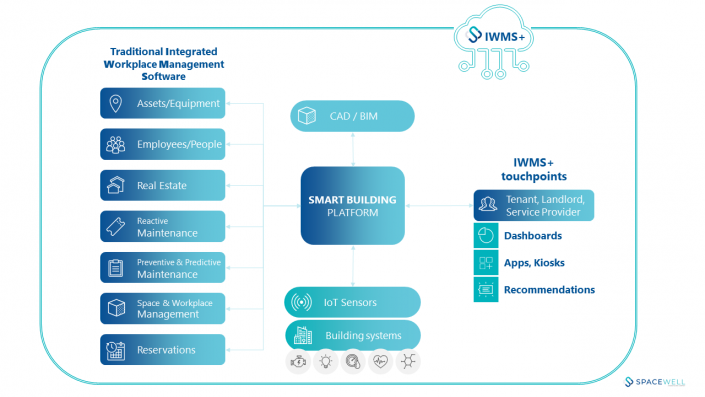By now, virtually no aspect of the real estate market has been left untouched by COVID-19 and the crisis response. Even before the emergence of the virus, the market was experiencing disruptions from the growth of coworking spaces, the explosion of Internet of Things (IoT) technologies, and the potential for machine learning and artificial intelligence. While many of us are focused on immediate crisis response, over the longer term, companies need to consider how to achieve better efficiencies, innovation, and resilience. They key to success under uncertainty is gathering better data, generating stronger insights, and developing effective ways to transform them into action. Software solutions that draw on Smart Buildings data and integrate them with building management tools are precisely how to achieve this. This next generation of property management software is IWMS+.
Deep integration

IWMS refers to an integrated workplace management software, a tool used by virtually all businesses – from brokers to landlords, from financial institutions to windfarms – to manage essential aspects of their business. IWMS can be used to log maintenance tickets, track conference room reservations, or manage rental contracts and inventory. It is elevated by IWMS+ when combined with Smart Buildings technologies to generate troves of real-time data about building usage and environmental factors. By integrating the two, IWMS+ helps monitor, assist, and transform workplaces by automating processes, offering granular insights, and helping to inform key decisions, such as how to best implement an agile workplace that saves space, time, and money all while improving the user experience.
The value proposition of the deep integration between the traditional IWMS and Smart Buildings falls into three categories that together generate short term financial and human benefits while also positioning users to implement transformational solutions and data-driven adaptation in the long-term.
Streamlining benefits
First, and most obviously, for customers that use both types of software already, IWMS+ can offer streamlining benefits by reducing the number of software applications in use. Switching from two separate applications to an integrated IWMS+ platform can reduce the risk of data transmission errors or losses, enhance analysis capabilities, improve the user experience by moving everything to a common interface that is accessible from a mobile app, lower subscription fees, and simplify troubleshooting.
For those only using an IWMS, expanding to IWMS+ can achieve competitive advantages, particularly in a difficult market. Whether by improving comfort levels, increasing the responsiveness of maintenance ticketing, or reducing time spent finding workspaces in an agile office environment, the addition of Smart Buildings technologies can greatly enhance the user experience, setting properties apart from the competition.
Integration drives innovation
Second, IWMS+ forms the foundation for cutting-edge technologies like machine learning and artificial intelligence (AI) in building management, which rely on huge quantities of reliable and relevant data. As such, IWMS+ generates tremendous innovation benefits. Early adoption of IWMS+ ensures that data-intensive technologies have a powerful set of training data to set initial baselines. Beyond AI, IWMS+ can facilitate rapid responses to emerging science about how to capture health improvements in office environments by monitoring air quality, temperature, humidity, air pressure, radon levels, and other metrics relevant to human health. Such monitoring may be required for certifications like the WELL Building Standard® or LEED.
Increasing resilience
Third, IWMS+ generates resilience benefits. The key to maintaining resilience in an ever-changing market is to continuously optimize, anticipate, and adapt, all of which require an in-depth understanding of how properties are being used and how patterns of usage are changing. IWMS+ can facilitate decision-making about office footprints, floor design, maintenance strategies, and alert managers of disruptions to speed up adaptations.
Already, IWMS+ is being used to optimize agile workplace conversions, allowing building managers to save space while also ensuring user comfort and functionality by leveraging data on actual usage patterns. As norms around remote work continue to change, we are likely to see substantial changes in the space requirements for offices around the world – gathering accurate information about just how those norms translate into practice will help property managers determine the future of their leases, renovations, or new constructions.
Together, streamlining, innovation, and resilience benefits have the potential to generate financial returns from cost savings, reputational returns from being a market leader, as well as substantial benefits from enhanced user satisfaction and health. The size of these returns will vary from client to client, but just as benefits can depend on the individual, so can IWMS+ solutions be tailored to individual circumstances.
Adapting to a changing world
The dislocations to building management produced first by the rise of coworking spaces and even more dramatically by the extensive shift towards remote working caused by COVID-19 reveal the importance of implementing systems that can help building managers efficiently and flexibly adapt to a changing world1. IWMS+ forms the technological backbone for many of the improvements that workplaces will need in order to both capture the upside potential and manage the risks of the modern work environment.
Spacewell is at the forefront of developments in IWMS+. We are the only company to be classified as a “Leader” in the Verdantix Green Quadrant reports for both Integrated Workplace Management Systems and IoT Platforms for Smart Buildings in 2019. While we offer individual software solutions for both IWMS and Smart Buildings, we are invested in expanding and improving our IWMS+ capabilities to bring the full potential of these technologies to our clients as they adapt to a changing world.
Spacewell is part of the Nemetschek Group, a publicly-traded company with a market capitalization of over $5.5 billion and over 25 years of leadership in the IWMS and Smart Buildings space. This means that our clients can be confident that Spacewell will be a stable partner even in turbulent times.
For more information on Spacewell’s capabilities, products, and thought leadership please contact us.
1 For Spacewell’s assessment of how IWMS+ can help companies respond to COVID-19 specifically, we recommend our recent article on the topic.

